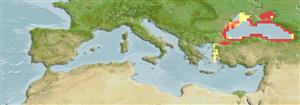Classification / Names
Common names from other countries
Main reference
Size / Weight / Age
Max length : 236 cm TL male/unsexed; (Ref. 59043); common length : 145 cm TL male/unsexed; (Ref. 3561); max. published weight: 115.0 kg (Ref. 6866); max. reported age: 46 years (Ref. 3561)
Length at first maturity
Lm ? range ? - ? cm
Environment
Marine; freshwater; brackish; demersal; anadromous (Ref. 51243); depth range 2 - 100 m, usually 10 - 25 m
Climate / Range
Temperate; 10°C - 20°C (Ref. 2059), preferred 11°C (Ref. 107945); 61°N - 35°N, 26°E - 54°E
Distribution
Eurasia: Black Sea, Sea of Azov and Caspian Sea, entering all main rivers that empty into them (Don, Kuban, Danube, Dnieper (rare), Dniester) (Ref. 9953). Introduced throughout Europe. Considered critically endangered (Ref. 59043). International trade restricted (CITES II, since 1.4.98; CMS Appendix II).
Countries | FAO areas | Ecosystems | Occurrences | Introductions
Short description
Dorsal
spines
(total): 0;
Dorsal
soft rays
(total): 27-48;
Anal
soft rays: 16 - 35. Under the name A. g. colchicus. Lower lip not continuous, interrupted at center. Five rows of scutes: dorsal 7-19, lateral 24-44 on each side, ventral 6-13 on each side, with lines of smaller stellate bony plates between the dorsal and ventral rows. Color of back olivaceous grey, flanks lighter, and belly white.
IUCN Red List Status (Ref. 115185)
Threat to humans
Harmless
Human uses
Fisheries: commercial; aquaculture: commercial; aquarium: public aquariums
More information
ReferencesAquacultureAquaculture profileStrainsGeneticsAllele frequenciesHeritabilityDiseasesProcessingMass conversion
Tools
Special reports
Download XML
Internet sources
Estimates of some properties based on models
Phylogenetic diversity index
PD50 = 0.5000 many relatives (e.g. carps) 0.5 - 2.0 few relatives (e.g. lungfishes)
Trophic Level
3.3 ±0.1 se; Based on diet studies.
Resilience
Very Low, minimum population doubling time more than 14 years (tm=11; Fec = 26,000)
Vulnerability
Very high vulnerability (87 of 100)
Price category
